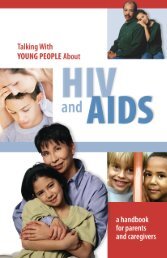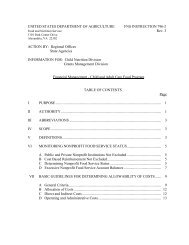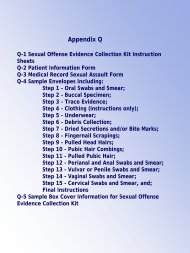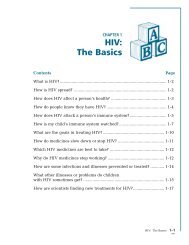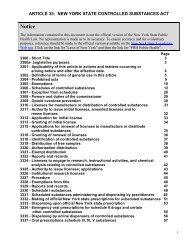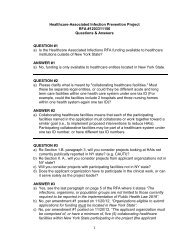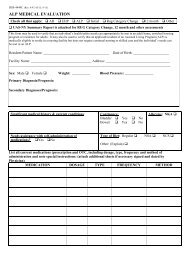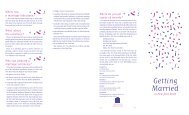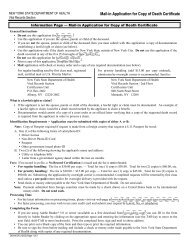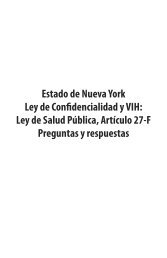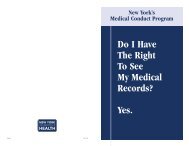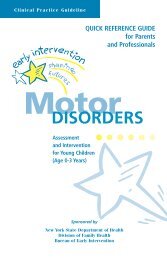Logging Safety: A Field Guide - New York State Department of Health
Logging Safety: A Field Guide - New York State Department of Health
Logging Safety: A Field Guide - New York State Department of Health
Create successful ePaper yourself
Turn your PDF publications into a flip-book with our unique Google optimized e-Paper software.
LOGGING SAFETY: A F I ELD GUIDE<br />
<strong>New</strong> <strong>York</strong> Fatality Assessment<br />
and Control Evaluation Program<br />
<strong>New</strong> <strong>York</strong> <strong>State</strong> <strong>Department</strong> <strong>of</strong> <strong>Health</strong>
Introduction<br />
<strong>Logging</strong> has consistently been one <strong>of</strong> the most hazardous industries in the<br />
United <strong>State</strong>s.<br />
• 95 workers were fatally injured in the U.S. logging industry in 2006, resulting<br />
in a fatality rate <strong>of</strong> 85.6 deaths per 100,000 workers. The fatality rate for all<br />
occupations in the U.S. in 2006 was 4.0 deaths per 100,000 workers.<br />
• 40 workers were killed in <strong>New</strong> <strong>York</strong> <strong>State</strong> while performing tree work, including<br />
logging, between 20022007.<br />
• 17% <strong>of</strong> logging employee fatalities are machine related accidents.<br />
• 40,000 logging injuries occurred in the U.S. in 2007. Total medical costs<br />
approached $300 million.<br />
The information in this booklet reviews the key elements <strong>of</strong> logging hazards and<br />
the OSHA <strong>Logging</strong> Standard requirements and suggests some preventive measures<br />
that can help loggers and other tree workers to reduce injuries and work safely.<br />
1
Table <strong>of</strong> Contents<br />
SECTION ONE: <strong>Logging</strong> Personal Protective Equipment (PPE) . . . . . . . . . . . . 3<br />
SECTION TWO: Chain Saw <strong>Safety</strong> . . . . . . . . . . . . . . . . . . . . . . . . . . . . . . . . . . . . . 12<br />
SECTION THREE: Manual Felling . . . . . . . . . . . . . . . . . . . . . . . . . . . . . . . . . . . . . 19<br />
SECTION FOUR: Limbing and Bucking. . . . . . . . . . . . . . . . . . . . . . . . . . . . . . . . . 35<br />
SECTION FIVE: Skidding/Yarding . . . . . . . . . . . . . . . . . . . . . . . . . . . . . . . . . . . . . 45<br />
SECTION SIX: Loading and Transporting. . . . . . . . . . . . . . . . . . . . . . . . . . . . . . . 48<br />
SECTION SEVEN: Machines and Vehicles . . . . . . . . . . . . . . . . . . . . . . . . . . . . . . 52<br />
SECTION EIGHT: Chemicals. . . . . . . . . . . . . . . . . . . . . . . . . . . . . . . . . . . . . . . . . . . 64<br />
SECTION NINE: Signaling and Signal Equipment. . . . . . . . . . . . . . . . . . . . . . . 66<br />
SECTION TEN: First Aid and Emergencies . . . . . . . . . . . . . . . . . . . . . . . . . . . . . 67<br />
SECTION ELEVEN: <strong>Logging</strong> <strong>Safety</strong> Program. . . . . . . . . . . . . . . . . . . . . . . . . . . . 80<br />
APPENDIX: Glossary <strong>of</strong> <strong>Logging</strong> Terms. . . . . . . . . . . . . . . . . . . . . . . . . . . . . . . . 96<br />
Acknowledgments . . . . . . . . . . . . . . . . . . . . . . . . . . . . . . . . . . . . . . . . . . . . . . . . . 107<br />
2
S ECT I ON ONE<br />
<strong>Logging</strong> Personal Protective Equipment (PPE)<br />
• Use to protect the head, ears, eyes,<br />
face, hands, legs and feet.<br />
• Wear even in hot weather.<br />
• Inspect before each use.<br />
• Does NOT eliminate the hazards!<br />
Training and enforcement <strong>of</strong> PPE use<br />
are responsibilities <strong>of</strong> the employer.<br />
Employer must provide PPE to employees<br />
at no cost (except boots).<br />
1<br />
<strong>Logging</strong> Personal Protective Equipment (PPE)<br />
3
1<br />
<strong>Logging</strong> Personal Protective Equipment (PPE)<br />
Head Protection<br />
Many loggers are killed by being struck in the head by falling/flying objects<br />
(limbs, branches, etc.). Even the smallest piece <strong>of</strong> wood can be deadly.<br />
• Hard hats must be worn!<br />
• Hard hats are designed to absorb energy.<br />
• Hard hats should be <strong>of</strong> a high visibility color.<br />
• Head protection must be ANSI approved;<br />
look for the ANSI Z89.1 stamp.<br />
4
Hearing Protection Noise Facts 1<br />
• Time Weighted Average (TWA) represents the average noise level you are<br />
exposed to in an 8hour workday including all levels <strong>of</strong> noise experienced.<br />
• Workplace exposure limits are expressed in units <strong>of</strong> dBA. Decibels are measured<br />
using an Aweighted scale for noise level, which adjusts noise measurements<br />
using a builtin Aweighted filter that largely ignores low frequency sound<br />
energy just as the human ears do.<br />
• OSHA requires that all employers administer a hearing conservation program<br />
whenever worker noise exposures equal or exceed 8hour TWA <strong>of</strong> 85 dBA.<br />
• Long or repeated exposure to sounds at or above 85 dBA can cause hearing loss.<br />
• Some hearing loss occurs naturally as you age.<br />
• Workrelated hearing loss and noiseinduced hearing loss from recreational<br />
activities may be irreversible.<br />
• Hearing loss may impact your enjoyment <strong>of</strong> life.<br />
• Ears are not designed to deal with harmful loud noises, such as that produced<br />
by a chainsaw (110 dBAs).<br />
• Hearing loss may be gradual, so it is not always obvious.<br />
• Noise may increase your blood pressure. 5<br />
<strong>Logging</strong> Personal Protective Equipment (PPE)
1 Hearing Protection: Typical Noise Levels & Time Weighted Averages<br />
<strong>Logging</strong> Personal Protective Equipment (PPE)<br />
– Loader: 85 TWA (dBA)<br />
– Skidder: 88 TWA (dBA)<br />
– Dozer: 97 TWA (dBA)<br />
– Timber Cutter: 104 TWA (dBA)<br />
• Remember the timber cutter’s 104 dBA level takes into account that the saw<br />
only runs about half <strong>of</strong> the time!<br />
• The dozer and timber cutter operators’ noise exposures exceed 90 TWA (dBA);<br />
they need hearing protection!<br />
• PROTECT YOUR EARS! ALL LOGGING WORKERS SHOULD USE HEARING<br />
PROTECTION.<br />
6
Hearing Protection<br />
• Whenever workers’ noise exposures equal or exceed an 8 hour TWA <strong>of</strong> 85dBA,<br />
hearing protection is required.<br />
• Employers must make hearing protection available for all workers at no cost<br />
to the workers.<br />
• Employees must wear hearing protection, such as ear muffs or ear plugs.<br />
Cotton balls are not acceptable protection.<br />
• The hearing protection:<br />
– Must be capable <strong>of</strong> limiting exposure to less than 90 Decibels (dBA)<br />
for 8 hours (use NRR rating*).<br />
– Must be used and cared for according to the manufacturer.<br />
– Must be kept clean so as to avoid infecting the ear.<br />
*NRR is the Noise Reduction Rating listed on each hearing protection container.<br />
1<br />
<strong>Logging</strong> Personal Protective Equipment (PPE)<br />
7
1 Eye and Face Protection<br />
<strong>Logging</strong> Personal Protective Equipment (PPE)<br />
• Eye and face protection must be worn<br />
for all logging operations.<br />
• Loggertype mesh screens are<br />
considered adequate eye and face<br />
protection for chain saw users.<br />
• Equipment must comply with ANSI<br />
standards; look for the ANSI stamp.<br />
• Do NOT wear regular glasses or<br />
sunglasses.<br />
8
Leg Protection 1<br />
Each worker who operates a chain saw must<br />
wear leg protection, commonly in the form<br />
<strong>of</strong> saw chaps.<br />
• Chaps are made <strong>of</strong> cutresistant material<br />
such as Kevlar or ballistic nylon.<br />
• Chaps must extend from upper thigh down<br />
to boot top.<br />
• Chaps must be Underwriters Laboratories<br />
(UL) approved; check the tag located on<br />
the outside <strong>of</strong> the chaps.<br />
• The average cost <strong>of</strong> chaps is $75.00.<br />
The average medical cost for a leg injury<br />
from a chain saw is $7,500.<br />
Trousers should be kept at proper length<br />
to prevent tripping hazards. NO CUFFS!<br />
<strong>Logging</strong> Personal Protective Equipment (PPE)<br />
9
1 Foot and Hand Protection<br />
<strong>Logging</strong> Personal Protective Equipment (PPE)<br />
• Employers must ensure that workers wear foot protection.<br />
– Boots should be heavy duty and waterrepellent.<br />
– Boots should cover and support the ankle.<br />
– Cutresistant boots are required by OSHA for chain saw operators.<br />
They must be UL approved.<br />
• Employers must require and provide hand protection for all workers who<br />
are exposed to hand hazards.<br />
– Gloves are required for all workers who handle wire rope.<br />
– Gloves for wire rope handling should be cotton or equivalent.<br />
10
Torso/Upper Body Protection<br />
• Clothing should be properly fitted.<br />
– No dangling shirt tails.<br />
– No cuffs.<br />
– No loose or fraying materials.<br />
– No bare skin; cover up even<br />
in hot weather.<br />
What PPE does this tree worker need?<br />
Hearing Protection, Eye Protection,<br />
Loggers Mesh Face Shield, <strong>Safety</strong> Gloves, Loggers’<br />
Chaps, Heavy Duty and Cutresistant Boots<br />
1<br />
<strong>Logging</strong> Personal Protective Equipment (PPE)<br />
11
2<br />
Chain Saw <strong>Safety</strong><br />
S ECT I ON TWO<br />
Chain Saw <strong>Safety</strong><br />
• The chain saw is one <strong>of</strong> the most efficient, productive and dangerous portable<br />
power tools in any industry!<br />
• Proper operation and maintenance will increase both safety and productivity!<br />
• Chain saws must be in good condition and inspected before each shift.<br />
• Chain saws must be secured when transporting in vehicle or equipment cab.<br />
Unsecured tools can be a hazard to the operator, especially if a rollover occurs.<br />
Review the operator’s manual and follow the manufacturer’s instructions!<br />
12
Chain Saw Injury Locations (U.S.)<br />
Note: most injuries occur on the lower left leg and thigh, the left arm and the back<br />
<strong>of</strong> the left hand. Be sure to protect your body.<br />
2<br />
Chain Saw <strong>Safety</strong><br />
13
2 Know the <strong>Safety</strong> Features <strong>of</strong> a Chain Saw<br />
Chain Saw <strong>Safety</strong><br />
• Side cover plates: intact<br />
• Throttle trigger<br />
• Muffler<br />
• Hand guard<br />
• Chain catcher<br />
• Antivibration<br />
handle system<br />
• Throttle trigger lockout<br />
• Chain brake (gasoline only)<br />
Make sure that all safety features that are on the saw are functional.<br />
Always check before each use!<br />
14
Before Starting Your Chain Saw Always<br />
• Check for properly sharpened chain.<br />
• Check controls, chain tension, bolts, and handles.<br />
• Adjust according to manufacturer’s instructions.<br />
• Fuel at least 10 ft. from ignition sources.<br />
• Start at least 10 ft. away from fuel.<br />
• Start with chain brake on, while standing on level ground<br />
or firmly supported.<br />
• Use approved metal or plastic fuel containers. Metal safety<br />
cans are the best choice.<br />
2<br />
Chain Saw <strong>Safety</strong><br />
15
2 While Running Your Chain Saw Always<br />
Chain Saw <strong>Safety</strong><br />
• Keep hands on handles.<br />
• Maintain secure footing.<br />
• Eliminate cutting overhead.<br />
• Keep your cutting area and your retreat path free <strong>of</strong> obstacles.<br />
• Shut saw <strong>of</strong>f or release throttle prior to retreating.<br />
• Shut saw <strong>of</strong>f or engage the chain brake if the terrain is hazardous<br />
or if you are traveling more than 50 ft.<br />
16
Chain Saw Maintenance<br />
• Read and study the operator’s manual.<br />
• Follow manufacturer’s instructions.<br />
• Inspect, operate, adjust, sharpen, maintain and repair regularly.<br />
2<br />
Chain Saw <strong>Safety</strong><br />
A sharp and well maintained saw<br />
increases production, decreases<br />
fatigue and helps prevent injury<br />
and accident.<br />
17
2 Chain Saw Operation Checklist<br />
Chain Saw <strong>Safety</strong> Checklist<br />
18<br />
■ Do you inspect your saw at the beginning <strong>of</strong> each shift?<br />
■ Are the safety features <strong>of</strong> your chain saw working properly?<br />
■ Is your saw adjusted and used according to the manufacturer?<br />
■ Do you fuel your saw at least 10 feet from ignition sources?<br />
■ Do you start your saw at least 10 feet from the fuel sources?<br />
■ Do you start your saw with the chain brake on and firmly supported<br />
or on the ground?<br />
■ Do you keep both hands on the saw and your footing secure?<br />
■ Do you keep your cutting area and retreating path free <strong>of</strong> obstacles?<br />
■ Do you avoid cutting overhead?<br />
■ Do you shut <strong>of</strong>f the saw release or throttle before you retreat?<br />
■ Do you shut <strong>of</strong>f the chain saw or engage the chain brake if the terrain<br />
is hazardous or if you are moving more than 50 feet?
S ECT I ON THREE<br />
Manual Felling<br />
The Cold Hard Facts<br />
• More loggers are hurt and killed during felling than any other activity!<br />
• Most who die at work are killed within 10 feet <strong>of</strong> the stump.<br />
• These accidents can be avoided!<br />
3<br />
Manual Felling<br />
To Safely Fell Any Tree You Should…<br />
• Use proper personal protective equipment (PPE).<br />
• Identify potential hazards and ways to avoid or eliminate hazards.<br />
• Determine the best felling direction.<br />
19
3 • Plan, clear and use an escape path.<br />
Manual Felling<br />
• Figure out the proper hinge size.<br />
• Perform the correct cut.<br />
• Use proper controlled felling by making the correct cuts.<br />
This group <strong>of</strong> workers are<br />
taking the time to work out<br />
a safe felling plan.<br />
20
Potential Felling Hazards and Ways to Eliminate or Avoid Them<br />
Potential Hazard Description Ways to Eliminate or Avoid<br />
Throwback<br />
Dangerous Terrain<br />
As the tree falls through other<br />
trees or lands on objects, those<br />
objects or branches may get<br />
thrown back toward the logger.<br />
If the tree falls onto stumps,<br />
rocks, or uneven ground,<br />
a hazard may be created.<br />
If possible, avoid felling into<br />
other trees or onto objects.<br />
If possible, move the obstacle<br />
or change the felling direction.<br />
3<br />
Manual Felling<br />
Lodged Tree<br />
(Hang)<br />
A tree that has not fallen<br />
completely to the ground<br />
because it is lodged or leaning<br />
against another tree.<br />
Do NOT work around lodged<br />
trees. Push or pull down these<br />
death traps using a machine.<br />
Never cut the support tree.<br />
Widowmakers<br />
Broken<strong>of</strong>f limbs that are<br />
hanging freely in the tree to be<br />
felled or in trees close by.<br />
Knock them down or pull them<br />
down with a machine. Avoid<br />
working underneath them.<br />
21
3<br />
Potential Hazard Description Ways to Eliminate or Avoid<br />
Manual Felling<br />
Snag<br />
Spring Pole<br />
Standing dead tree, standing<br />
broken tree, or a standing rotted<br />
tree to be felled or nearby.<br />
A tree, segment <strong>of</strong> a tree, limb or<br />
sapling which is under stress or<br />
tension due to the pressure or<br />
weight <strong>of</strong> another tree or object.<br />
Use a machine to bring it down<br />
or it must be felled or avoided by<br />
at least two tree lengths.<br />
Use a machine to release the<br />
tension or release it with a chain<br />
saw by shaving wood from the<br />
underside (see limbing and<br />
bucking section).<br />
Extreme Weather<br />
Strong winds, hazardous snow<br />
or ice conditions, electrical<br />
storms, dense fogs, fires,<br />
landslides and darkness.<br />
Do NOT fell trees during these<br />
extreme weather conditions as<br />
they may impair vision and create<br />
serious hazards. Terminate work<br />
and move to safety.<br />
Other Workers<br />
and Machines<br />
Workers or machines in the<br />
immediate area.<br />
Request the workers or<br />
machines be removed.<br />
22
Plan Your Felling Direction<br />
Planning helps prevent damage to the<br />
trees and harm to you!<br />
• Clear a fall path and landing zone.<br />
• Think about the lean <strong>of</strong> the tree.<br />
• Think about the slope <strong>of</strong> the ground.<br />
Felling<br />
Direction<br />
3<br />
Manual Felling<br />
Escape Path… A Safe Retreat<br />
• Plan escape route at 45 degree angles<br />
from the sides and back on either side.<br />
Safe<br />
Danger Area<br />
Safe<br />
• Never move behind the tree<br />
to be felled!<br />
• Never assume that you can predict<br />
what a tree will do!<br />
*Source <strong>of</strong> information: OSHA<br />
• Expect the unexpected.<br />
23
3 Use an Escape Path: How to Retreat<br />
Manual Felling<br />
• Use the chain brake!<br />
• Use a bore cut and a release cut to give you enough time to retreat.<br />
• Don’t turn your back on a falling tree.<br />
• Quickly walk at least 20 feet away.<br />
• Try to position yourself behind a standing tree, if possible.<br />
24
Why a Felling Hinge?<br />
• It provides controlled directional felling.<br />
• It holds the tree to the stump during most <strong>of</strong> the tree’s fall.<br />
• It guides the tree in the intended direction.<br />
• It makes things more predictable!<br />
3<br />
Manual Felling<br />
25
3<br />
Manual Felling<br />
A Proper Hinge<br />
• The length <strong>of</strong> the hinge should be 80% <strong>of</strong> the diameter <strong>of</strong> the tree.<br />
– Example: For a 20 inch diameter tree, the hinge should be 16 inches long.<br />
– 20 inches x 80% (0.8) = 16 inches.<br />
• The thickness <strong>of</strong> the hinge should be 10% <strong>of</strong> the diameter <strong>of</strong> the tree.<br />
– Example: For a 20 inch diameter tree, the hinge should be 2 inches wide.<br />
– 20 inches x 10% (0.1) = 2 inches.<br />
Hinge<br />
Thickness<br />
Hinge Length<br />
26<br />
*Source <strong>of</strong> information: OSHA
Making the Cuts<br />
The felling <strong>of</strong> a tree includes making<br />
three precise cuts (top cut, bottom<br />
cut and back cut) to create one <strong>of</strong> the<br />
following three notches:<br />
• Openfaced notch SAFEST<br />
• Conventional notch LESS SAFE<br />
• Humbolt notch LEAST SAFE<br />
3<br />
Manual Felling<br />
27
3 Openfaced Notch SAFEST<br />
Manual Felling<br />
• Hinge closes just before tree hits<br />
the ground.<br />
• Provides a higher degree <strong>of</strong> safety<br />
and accuracy.<br />
• Less chance <strong>of</strong> kick back and<br />
out<strong>of</strong>control movement.<br />
28
3<br />
Openfaced Notch: Top Cut<br />
1. Start Point: Begin at any height.<br />
2. Angle <strong>of</strong> Attack: Cut downward at<br />
an angle <strong>of</strong> 70 degrees.<br />
3. Ending Point: Stop when the cut<br />
reaches 1/4 to 1/3 the tree’s diameter.<br />
Manual Felling<br />
*Source <strong>of</strong> information/pictures: OSHA<br />
29
3<br />
Manual Felling<br />
Openfaced Notch: Bottom Cut<br />
(Undercut)<br />
1. Start Point: Begin at a level that<br />
will give at least a 70 degree notch<br />
opening. Ideally, you want a 90<br />
degree opening.<br />
2. Angle <strong>of</strong> Attack: Cut upward at<br />
a 20 degree angle.<br />
3. Ending Point: Stop when the cut<br />
reaches the end point <strong>of</strong> the face cut.<br />
4. Don’t bypass the end point <strong>of</strong> your<br />
face cut, it will wreck your hinge!<br />
*Source <strong>of</strong> information/pictures: OSHA<br />
30
3<br />
Openfaced Notch: Back Cut<br />
1. Start Point: IMPORTANT Begin on<br />
the opposite side <strong>of</strong> the notch at the<br />
same level as the notched corner.<br />
2. Angle <strong>of</strong> Attack: Cut flat along<br />
a horizontal plane.<br />
3. Ending Point: VERY IMPORTANT<br />
Stop at a point that will leave a hinge<br />
width 1/10 <strong>of</strong> the tree’s diameter.<br />
Manual Felling<br />
*Source <strong>of</strong> information/pictures: OSHA<br />
31
3 Conventional Notch LESS SAFE<br />
Manual Felling<br />
• Hinge closes in the middle<br />
<strong>of</strong> the fall.<br />
• Lesser degree <strong>of</strong> safety.<br />
• Less accuracy.<br />
• More chance <strong>of</strong> kick back.<br />
• Hinge breaks early.<br />
32
Humbolt Notch<br />
LEAST SAFE<br />
3<br />
• Hinge closes in the middle<br />
<strong>of</strong> the fall.<br />
• Lesser degree <strong>of</strong> safety.<br />
• Less accuracy.<br />
• More chance <strong>of</strong> kick back.<br />
• Saves a little wood; is NOT worth<br />
the risk.<br />
Manual Felling<br />
33
3 Safe Felling Checklist<br />
Manual Felling Checklist<br />
■ Are you wearing all <strong>of</strong> your PPE (hard hat, chaps, eye and face protection,<br />
hand and foot protection)?<br />
■ Is your work zone free from danger trees, hangs, snags, and dead limbs?<br />
■ Did you look over the position, condition, and lean <strong>of</strong> the tree?<br />
■ Is the situation hazardous or unfamiliar?<br />
■ If so, did you talk to your supervisor about it?<br />
■ Do you have a clear fall path and landing zone?<br />
■ Have you planned and cleared an escape path?<br />
■ Do you plan on using controlled directional felling?<br />
■ Will the technique include a notch and back cut that leaves a sufficient hinge?<br />
■ Are you at least two tree lengths from other workers and machines?<br />
34
S ECT I ON FOUR<br />
Limbing and Bucking<br />
Limbing is cutting branches <strong>of</strong>f felled or standing trees. Bucking is sawing<br />
felled trees into sections called logs.<br />
• Many loggers are hurt and sometimes killed during limbing and bucking<br />
operations.<br />
• Never limb a tree just after felling; allow more time for overhead hazards<br />
to come down before limbing.<br />
• Felled trees <strong>of</strong>ten have a great amount <strong>of</strong> stored energy in their limbs and stems.<br />
• Loggers must release this energy in a controlled manner.<br />
4<br />
Limbing and Bucking<br />
35
4 Limbing and Bucking<br />
Limbing and Bucking<br />
• Limb and buck on the uphill side <strong>of</strong> each tree or log, where rolling or sliding<br />
<strong>of</strong> logs may be expected.<br />
• Chock or move logs to stable positions to prevent the logs or the butt from<br />
striking loggers.<br />
• Do NOT cut above the level <strong>of</strong> your shoulder when limbing.<br />
36
Before Limbing<br />
Check for potential hazards:<br />
• Look for overhead hazards such as hanging limbs and rolling trees.<br />
• Check for spring poles.<br />
• Look for butt movement forward (creates back pressure on limbs).<br />
• Look for butt twist (creates sideways pressure on limbs).<br />
• Check if the butt is <strong>of</strong>f the ground (creates tension and compression<br />
on the tree stem).<br />
Before Bucking<br />
Check for potential hazards:<br />
• Look for steep terrain and rolling trees (see below).<br />
• Relieve tension for top bind and bottom bind.<br />
4<br />
Limbing and Bucking<br />
37
4 Rolling Trees<br />
Limbing and Bucking<br />
• Use tongue and groove cuts if there is danger <strong>of</strong> tree or part <strong>of</strong> tree rolling<br />
on the logger.<br />
– The stem <strong>of</strong> the tree is first bored in the center.<br />
– Up and down cuts are made either closer to the top or butt <strong>of</strong> the tree.<br />
– Each cut must bypass the bore cut but do not meet.<br />
– With all fiber severed, the tongue and groove will prevent tree from rolling.<br />
38<br />
*Source <strong>of</strong> information: OSHA
Spring Poles<br />
• Safest way to release a spring pole is to shave a sufficient amount <strong>of</strong> wood<br />
from the underside to allow the wood fiber on the top to release slowly.<br />
• To find the best point to shave or release spring pole:<br />
– Determine straight vertical line up from stump.<br />
– Find where it meets a horizontal line from highest point <strong>of</strong> the bend.<br />
– Come down at 45 degree angle from where two lines intersect.<br />
4<br />
Limbing and Bucking<br />
*Source <strong>of</strong> information/pictures: OSHA<br />
39
4 Butt Movement Forward: Butt Twist <br />
Back and Sideways Pressure on Limbs<br />
Limbing and Bucking<br />
• Limbs with back pressure can severely injure a logger. Use a limb lock to prevent<br />
injury. The limb lock prevents a limb under pressure from kicking back and<br />
striking the logger or pinching the saw.<br />
– Make the first cut on either top side or<br />
bottom side <strong>of</strong> limb (top and bottom refer to<br />
limb position as if the tree were standing up)<br />
on the side with compression pressure.<br />
– Make the top cut on the limb closer<br />
to the trunk.<br />
– Make the bottom cut further out on the limb.<br />
– Make sure the two cuts bypass to sever<br />
all fiber.<br />
40<br />
*Source <strong>of</strong> information: OSHA
Butt <strong>of</strong>f the Ground:<br />
Tension and Compression on the Stem<br />
• Twisting <strong>of</strong> trees and butts <strong>of</strong>f the ground create pressure on stem.<br />
• Use a top lock to prevent the top from kicking up.<br />
– Make the first cut on side <strong>of</strong> tree <br />
under compression, in the top<br />
or bottom <strong>of</strong> the stem.<br />
– Make the second cut on the <br />
side under tension to prevent <br />
pinching the saw.<br />
– Make the top cut closer to the<br />
top <strong>of</strong> the tree and bottom cut<br />
closer to the bottom.<br />
– Both cuts must bypass so that all fiber is severed.<br />
4<br />
Limbing and Bucking<br />
*Source <strong>of</strong> information/pictures: OSHA<br />
41
4 Top Bind<br />
Limbing and Bucking<br />
• Arrows show saw travel.<br />
• Center is heartwood that will break.<br />
• May want to use end <strong>of</strong> the bar to<br />
bore from point “C” to make cuts<br />
(1) & (3), if there is danger <strong>of</strong> log<br />
slabbing (lateral split <strong>of</strong> a log).<br />
• Note: If the top bind is excessive,<br />
a wedge section could be removed<br />
to allow the tree cut to close as cuts<br />
(4) and (5) are made.<br />
42<br />
*Source <strong>of</strong> information/pictures: OSHA
Bottom Bind<br />
• Cuts similar to top bind, except top<br />
and bottom cuts are reversed.<br />
4<br />
Limbing and Bucking<br />
*Source <strong>of</strong> information/pictures: OSHA<br />
43
4 Limbing and Bucking Checklist<br />
Limbing and Bucking Checklist<br />
■ Are there any overhead hazards?<br />
■ Have any spring poles been created?<br />
■ If so, will they be mechanically released or released by properly shaving<br />
wood from the underside?<br />
■ Are you planning on limbing and bucking on the uphill side <strong>of</strong> the log?<br />
■ Will the log move or roll?<br />
■ If so, have you chocked the log or planned to use cuts such as the top lock<br />
or tongue and groove to control log movement?<br />
■ If you are bucking a windthrown tree, have you chocked the root wad<br />
to prevent it from hitting you?<br />
44
S ECT I ON FI VE<br />
Skidding/Yarding<br />
• Next to felling, skidding is the most dangerous part <strong>of</strong> a logging operation.<br />
• Getting the timber to the loading area safely requires good communication<br />
and safe work practices.<br />
• Skidding hazards include:<br />
– Moving equipment<br />
– Moving and rolling logs<br />
– Cable releases<br />
– Cablerelated cuts and punctures<br />
– Rollovers<br />
5<br />
Skidding/Yarding<br />
45
5 Skidding <strong>Safety</strong><br />
Skidding/Yarding<br />
• Hook and unhook chokers from the end <strong>of</strong> the log on the uphill side (unless log<br />
is securely chocked).<br />
• Position yourself in clear view <strong>of</strong> equipment operators.<br />
• Communicate clearly with the yarding machine operator to signal the movement<br />
<strong>of</strong> the line.<br />
• Move the line only after receiving a clear signal (yarding machine operator)!<br />
• Ensure winching is done within the stability limits <strong>of</strong> the machine.<br />
• Place each yarded tree in a location that does not cause a hazard.<br />
46
Skidding/Yarding Checklist<br />
■ Are chokers hooked and unhooked from end <strong>of</strong> the log on the uphill side?<br />
■ Are workers on foot within clear view <strong>of</strong> the skidder operators?<br />
■ Are operators waiting for the signal before moving the line?<br />
■ Is winching being done within the stability limits <strong>of</strong> the machine?<br />
■ Are cable handlers wearing gloves?<br />
■ Are operators wearing seat belts?<br />
■ Are yarded trees being placed in a location that does not cause a hazard?<br />
5<br />
Skidding/Yarding Checklist<br />
47
6<br />
S ECT I ON SIX<br />
Loading and Transporting<br />
Loading and Transporting<br />
• The loading and unloading <strong>of</strong> log<br />
trucks can be extremely dangerous.<br />
• Loading within safe limits and<br />
using safe work practices can ensure<br />
a safe operation.<br />
48
Loading and Transporting<br />
• Only the machine operator and necessary workers are allowed in the<br />
loading area.<br />
• Log truck drivers must be out <strong>of</strong> the cab if logs are moved over the cab<br />
(unless protected by reinforcement <strong>of</strong> the cab or other effective means).<br />
• Each tie down must be left in place over the peak log until the unloading<br />
lines or stakes are put in place. Tie downs must be released only from<br />
the side on which the unloading machine operates.<br />
• The logging truck must be positioned to provide working clearance between<br />
the truck and the deck.<br />
• The load must be positioned to prevent slippage during handling and transport.<br />
• The safest load is one in which the logs never go above the stanchions!<br />
6<br />
Loading and Transporting<br />
49
6 The Loading Danger Zones<br />
Loading and Transporting<br />
• Danger zones are on both sides <strong>of</strong> the log truck behind the cab.<br />
• If any person is in a hazard area, the loader operator cannot perform any work<br />
that could cause logs to move or fall.<br />
50
Loading and Transporting Checklist<br />
■ Are only authorized necessary workers in the area or within the danger zone?<br />
■ Is there working clearance between the truck and logs being loaded?<br />
■ Is the driver out <strong>of</strong> the cab?<br />
■ Are the logs being loaded to prevent slippage?<br />
■ Is the height <strong>of</strong> the logs being kept well below the truck’s stanchions?<br />
■ Are the logs secured immediately after loading and before moving the truck?<br />
■ Are the tie downs left in place until unloading lines or stakes are put in place?<br />
■ Are tie downs released from the side on which the unloading machine<br />
operates?<br />
6<br />
Loading and Transporting Checklist<br />
51
7<br />
Machines and Vehicles<br />
S ECT I ON SEVEN<br />
Machines and Vehicles<br />
Machines are selfpropelled power plants designed<br />
to be used <strong>of</strong>froad, primarily as material movers.<br />
Vehicles are personnel and material conveyances<br />
operated on highways as well as <strong>of</strong>froad.<br />
• Safe machine and vehicle use to prevent injury<br />
requires operating them in a manner that will protect all employees.<br />
– Know how to inspect, operate, and maintain your equipment.<br />
– Have effective safety guards installed and used.<br />
– Know the equipment limitations, your limitations and do not take risks!<br />
• Machines/vehicles can present hazards to the operators and other employees<br />
in or on the machines or vehicles or in the vicinity <strong>of</strong> the operations.<br />
52
General <strong>Safety</strong> for Machines/Vehicles<br />
• Machines/vehicles must be maintained in serviceable condition and inspected<br />
at the beginning <strong>of</strong> each shift.<br />
• If any defect or damage is found that would affect safe operation, the<br />
machines/vehicles MUST NOT BE USED.<br />
• Operating and maintenance instructions should be in each machine/vehicle;<br />
operators and maintenance employees must comply with these.<br />
• Machines must be started and operated by designated employees. The employer<br />
must assure that each vehicle operator has a valid operator's license for the class<br />
<strong>of</strong> vehicle being operated.<br />
• Seats must be securely fastened and seat belts used by persons operating<br />
or riding in or on mobile machines or vehicles.<br />
• Tools being transported must be secured by racks, boxes, holsters or other<br />
means so that a hazard is not created for any machine/vehicle operator<br />
or passenger.<br />
7<br />
Machines and Vehicles<br />
53
7 • Machines and vehicles used to transport employees <strong>of</strong>f public roads or on<br />
logging operations must meet applicable requirements.<br />
Machines and Vehicles<br />
• Operators <strong>of</strong> stationary machines with Rollover Protective Structure (ROPS),<br />
Falling Object Protective Structure (FOPS) or overhead guards must wear<br />
seat belts.<br />
• Machines must have a portable fire extinguisher that is properly maintained<br />
and fully charged.<br />
54
Inspections are Important<br />
• Perform inspections at the beginning <strong>of</strong> each shift.<br />
• Report problems to your supervisor.<br />
• Correct defects that affect safe operation immediately. Do NOT use the<br />
machine/vehicle if defects are not corrected.<br />
Defective machines can kill!<br />
What Should You Inspect?<br />
• Obtain the manufacturers’ prestart inspection lists.<br />
• Keep a laminated copy on each machine/vehicle.<br />
• Start at the same point each time and work your way around the machine/vehicle.<br />
• Look for any defect which could affect the operation or safety.<br />
• Report any problems to your supervisor.<br />
• Correct the problem immediately or take the machine/vehicle out <strong>of</strong> service until<br />
the defect or damage is repaired.<br />
7<br />
Machines and Vehicles<br />
55
7 Protective Controls for Operators<br />
Machines and Vehicles<br />
• Protective controls include cabs, rollover protective structures (ROPS), falling object<br />
protective structures (FOPS), overhead guards and operator restraint devices.<br />
– The controls must meet applicable OSHA standards.<br />
– The controls must be used to protect workers from injuries and fatalities<br />
from rollovers and falling objects.<br />
– The controls must provide maximum visibility.<br />
– The seat belts confine operators to the protective zone.<br />
56<br />
Seat Belts: Make It a Habit!<br />
• Each year many operators are crushed and killed due to rollovers. Many <strong>of</strong> them<br />
were not wearing seat belts.<br />
– Seat belts must be used by all persons operating or riding in or on<br />
machines and vehicles.<br />
– Seat belts must be worn by operators <strong>of</strong> stationary machines with ROPS,<br />
FOPS or overhead guards.<br />
– Seat belts must never be removed.
Visibility and <strong>Safety</strong><br />
Visibility and safety go handinhand!<br />
• Keep all vehicle and machine glass clean and free from scratches.<br />
• Replace any broken, missing or cracked glass.<br />
• Install deflectors in the front <strong>of</strong> cabs to deflect whipping saplings and branches.<br />
Ensure that deflectors do not block visibility or access.<br />
Fire Prevention<br />
• Portable fire extinguishers must be installed in each machine or vehicle.<br />
• Fire extinguishers must be the correct type for the hazards to be encountered.<br />
• Fire extinguishers should be inspected at the beginning <strong>of</strong> each shift as part<br />
<strong>of</strong> the vehicle or machine inspection.<br />
• Fire extinguishers must be properly maintained and fully charged.<br />
7<br />
Machines and Vehicles<br />
57
7 Machine Operation<br />
Machines and Vehicles<br />
• Machines must be operated at a distance from other workers and equipment<br />
so that the operation will not create a hazard.<br />
• Before leaving a machine, the operator must secure it by:<br />
– Placing transmission in park position.<br />
– Applying the parking brake or brake locks.<br />
– Placing each moving part (such as blades, buckets, saws and shears)<br />
to the ground and securing properly.<br />
– Discharging any stored energy or pressure in moving pneumatic<br />
or hydraulic elements.<br />
• The operator must follow the proper shut down procedure specified by<br />
the manufacturer.<br />
58
Brake and Exhaust Systems<br />
• Each machine must have:<br />
– Primary and secondary brakes that work properly.<br />
– Brakes that hold machine and its load under all conditions <strong>of</strong> use.<br />
– Parking brakes that continuously hold the stopped machine stationary.<br />
• Exhaust pipes must be:<br />
– Effectively muffled with muffler in place at all times when machine <br />
is in operation.<br />
– Located to direct exhaust away from the operator.<br />
– Guarded or mounted to protect operator from burns.<br />
– Equipped with spark arresters unless engine has turbochargers.<br />
7<br />
Machines and Vehicles<br />
59
7 Getting In and Out<br />
Machines and Vehicles<br />
• Each machine or vehicle cab must have a second means <strong>of</strong> exit.<br />
• Walking and working surfaces <strong>of</strong> each machine and machine work area must<br />
be slipresistant.<br />
• Surfaces must be kept free <strong>of</strong> waste, debris or other material that could cause<br />
fire, slipping or falling.<br />
Moving Parts and Flying Debris<br />
• Factory guards must be kept in place at all times.<br />
• Guards must protect worker from exposed moving elements such as gears,<br />
shafts, pulleys and belts.<br />
• Machines for debarking, limbing and chipping must have guards in place<br />
to protect workers from flying wood chunks, logs, chips, bark, limbs and<br />
other debris.<br />
60
Know Your Equipment Limitations<br />
This may prevent mishaps.<br />
• Follow manufacturer’s instructions for all machines and vehicles.<br />
• Don’t take unnecessary risks by pushing your equipment to the limit.<br />
• Learn the limitations <strong>of</strong> all machines and vehicles used.<br />
– Do NOT exceed the rated capacity <strong>of</strong> any vehicle transporting a machine.<br />
– Do NOT exceed the rated capacity <strong>of</strong> any machine to prevent rollovers <br />
and tipovers.<br />
– Do not place undue shock loads on wire rope.<br />
– Do observe speed limits and adjust speeds with changes in weather<br />
and road conditions.<br />
– Do NOT exceed the stated capacity <strong>of</strong> pallets and trailers.<br />
7<br />
Machines and Vehicles<br />
61
7 Stabilize Equipment<br />
Machines and Vehicles<br />
Poorly or partially stabilized equipment is dangerous. Workers have<br />
been killed when loading or unloading logging equipment that has been<br />
inadequately supported.<br />
• Follow manufacturer’s instructions.<br />
– Anchor or otherwise stabilize stationary logging machines and their<br />
components to prevent movement during operation.<br />
– Attach trailer equipment to the vehicle in such a way as to allow for full<br />
90 degree turn and to prevent overturning <strong>of</strong> the towing vehicle.<br />
– Follow load size and proper load handling guidelines.<br />
• Weather and physical environment may also change equipment stability.<br />
– Use mud sills in bad/rainy weather as needed.<br />
– Do not operate on any slope greater than maximum slope allowed.<br />
62
Machines and Vehicles Checklist<br />
■ Are machines/vehicles inspected at the beginning <strong>of</strong> each shift?<br />
■ Are machines/vehicles with defects that affect safe operation tagged and pulled<br />
from service until repaired?<br />
■ Are the manufacturer’s instructions located on each piece <strong>of</strong> equipment<br />
and are they followed?<br />
■ Are machines/vehicles operated only by designated, trained and licensed workers?<br />
■ Are machines with ROPS, FOPS or overhead guards equipped with seat belts?<br />
Are the belts worn by the operators?<br />
■ Does each piece <strong>of</strong> equipment have its own fully charged portable fire<br />
extinguisher?<br />
■ Are machines operated to maintain “two tree length” safety zone for other<br />
workers?<br />
■ Before leaving a machine, does the operator place the transmission in park,<br />
set the parking brake and ground each moving part?<br />
■ Are cabs free <strong>of</strong> unsecured tools and other loose items?<br />
7<br />
Machines and Vehicles Checklist<br />
63
8<br />
S ECT I ON EIGHT<br />
Chemicals<br />
Chemicals<br />
Flammable and combustible liquids are common to logging operations.<br />
• Fuels for vehicles, machinery and chain saws:<br />
– Must be stored, handled, transported and used according to<br />
OSHA standards.<br />
– Must NOT be transported in the driver compartment or in any<br />
passengeroccupied area <strong>of</strong> a machine or vehicle.<br />
– Can be used to start fires if the particular situation doesn’t create<br />
a hazard to workers.<br />
• Gaspowered equipment must be shut <strong>of</strong>f when fueling.<br />
• Dieselpowered equipment may be left at idle when fueling, assuming safe<br />
fueling procedures are followed.<br />
64
Explosives and Blasting Agents<br />
• Can present a hazard if stored, transported or handled improperly<br />
– Must be stored, handled, transported or used according<br />
to OSHA standards.<br />
– Must NOT be transported in the driver compartment or in any<br />
passengeroccupied area <strong>of</strong> a machine or vehicle.<br />
– Must be handled only by a designated person, trained in the handling<br />
and use <strong>of</strong> explosives and blasting agents.<br />
8<br />
Chemicals<br />
65
9<br />
S ECT I ON NI NE<br />
Signaling and Signal Equipment<br />
Signaling and Signal Equipment<br />
• Hand or audible signals (such as whistles,<br />
horns, or radios) must be utilized whenever<br />
noise, distance or other factors prevent clear<br />
understanding <strong>of</strong> normal voice communication.<br />
• The use <strong>of</strong> engine noise, such as from chain<br />
saws, CANNOT be used to maintain contact.<br />
66
S ECT I ON TEN<br />
First Aid and Emergencies<br />
Emergency Plan<br />
• <strong>Logging</strong> operations are <strong>of</strong>ten in remote areas far from emergency medical care.<br />
– Establish a sitewide communication system and a reliable way <strong>of</strong><br />
contacting EMS on the work site. Identify areas <strong>of</strong> cell phone reception<br />
or the phone(s) to be used in the event <strong>of</strong> an emergency.<br />
– Review the emergency plan and procedures for emergency contact with<br />
the employees at all work sites.<br />
– Discuss what to do if a serious injury occurs.<br />
• OSHA requires logging operations to be prepared for emergency medical care<br />
situations with first aid training and access to first aid.<br />
• First aid can <strong>of</strong>ten be a major factor in saving a life.<br />
10<br />
First Aid and Emergencies<br />
67
10 First Aid<br />
First Aid and Emergencies<br />
68<br />
• All employees, including supervisors, must be certified in First Aid and CPR.<br />
• First aid kits are required at each work site where trees are being cut, at each<br />
active landing, and on each employee transport vehicle.<br />
• The number <strong>of</strong> kits and content must reflect the degree <strong>of</strong> isolation, the number<br />
<strong>of</strong> employees, and the hazards anticipated.<br />
• Persons responding to accidents may be exposed to bloodborne diseases.<br />
– Avoid potential exposure by not contacting the blood or other infectious<br />
material.<br />
– Control the exposure if the blood or infectious material cannot be avoided<br />
entirely.<br />
– Use PPE to prevent direct contact with blood, bodily fluids or other<br />
potentially infectious material.<br />
• Workers should also be aware <strong>of</strong> first aid for insect bites, stings, tickborne<br />
diseases, and snake bites.
First Aid Kits Contents<br />
The minimum kit for a small work site <strong>of</strong> 23 people:<br />
• Gauze pads (at least<br />
4x4 inches)<br />
• Two large gauze pads<br />
(at least 8x10 inches)<br />
• Box adhesive bandages<br />
(bandaids)<br />
• One package gauze<br />
roller bandage (at least<br />
2 inches wide)<br />
• Two triangular<br />
bandages<br />
• Wound cleaning agent<br />
such as sealed<br />
moistened towelettes<br />
• Scissors<br />
• At least one blanket<br />
• Tweezers<br />
• Adhesive tape<br />
• Latex gloves<br />
• Resuscitation equipment<br />
such as resuscitation bag,<br />
airway, or pocket mask<br />
• Two elastic wraps<br />
• Splint<br />
• Instant ice packs<br />
(activate by squeezing)<br />
• Directions for requesting<br />
emergency assistance<br />
• Extractor (snake bite kit)<br />
For larger operation or multiple operation at the same location, provide additional<br />
kits or additional supplies. See Appendix A <strong>of</strong> the OSHA <strong>Logging</strong> Standard for<br />
minimum required contents.<br />
10<br />
First Aid and Emergencies<br />
69
10 First Aid Kits Should Be...<br />
First Aid and Emergencies<br />
• Kept clean.<br />
• Well stocked.<br />
• Inspected <strong>of</strong>ten.<br />
• Available when needed.<br />
• Kept in a visible location.<br />
• Located at each cutting site, landing, and in each worker transport vehicle.<br />
70
First Aid and CPR Training<br />
First Aid and CPR training and certificates must remain current. The basic<br />
elements <strong>of</strong> First Aid and CPR training should include:<br />
• The definition <strong>of</strong> first aid.<br />
• Legal issues <strong>of</strong> applying first aid (Good Samaritan Laws).<br />
• Basic anatomy.<br />
• CPR.<br />
• Application <strong>of</strong> dressings and slings.<br />
• Treatment <strong>of</strong> strains, sprains and slings.<br />
• Immobilization <strong>of</strong> injured persons.<br />
• Handling and transporting injured persons.<br />
• Treatment <strong>of</strong> bites, stings, or contact with poisonous plants or animals.<br />
10<br />
First Aid and Emergencies<br />
71
10 First aid and CPR training should include assessing patients<br />
with the following conditions:<br />
First Aid and Emergencies<br />
• Amputations<br />
• Burns<br />
• Cardiac arrest<br />
• Drug overdose<br />
• Eye injuries<br />
• Extreme temperature exposure<br />
(hypothermia/hyperthermia)<br />
• Hemorrhage<br />
• Lacerations/abrasions<br />
• Loss <strong>of</strong> consciousness<br />
• Loss <strong>of</strong> mental functioning<br />
(psychosis/hallucinations, etc.)<br />
• Musculoskeletal injuries<br />
• Paralysis<br />
• Poisoning<br />
• Respiratory arrest<br />
• Shock<br />
72
Cardiopulmonary Resuscitation (CPR)<br />
1. Time is <strong>of</strong> the essence. Follow the company emergency notification procedure<br />
to call 911.<br />
2. Open airway with head tilt and chin lift.<br />
3. Check for breathing (look, listen, feel).<br />
– If the victim is not breathing normally, provide 2 rescue breaths. <br />
(1 second each. Breaths should be normal, not deep breaths.)<br />
– Be sure the chest rises with each breath.<br />
– If chest does NOT rise, reopen airway; try again.<br />
4. Following TWO (2) rescue breaths, begin compressions.*<br />
– Place heel <strong>of</strong> one hand on the breastbone in the center <strong>of</strong> the chest<br />
between the nipples.<br />
– Place heel <strong>of</strong> second hand on top <strong>of</strong> the first so hands are overlapped<br />
and parallel (fingers are pointing in the same direction).<br />
10<br />
First Aid and Emergencies<br />
*If you are unwilling or unable to give rescue breaths, begin chest compressions.<br />
73
10<br />
First Aid and Emergencies<br />
– Compress lower half <strong>of</strong> breastbone (at nipple line) 1.5 to 2 inches.<br />
– Allow chest to recoil completely after compression.<br />
– Rate <strong>of</strong> about 100 times per minute. “Push hard and push fast.”<br />
– 30 compressions, then 2 rescue breaths (use normal 1 second breaths,<br />
not deep breaths).<br />
– Check for response every 2 minutes OR after 5 cycles <strong>of</strong> compression<br />
and ventilation at a ratio <strong>of</strong> 30 compressions to 2 breaths.<br />
– Continue until rescue personnel arrive.<br />
74
Head Injuries<br />
Lay victim down while keeping victim’s head and shoulders slightly raised.<br />
For bleeding scalp:<br />
1. Control bleeding with direct pressure. For suspected skull fracture, apply<br />
pressure to the outside edges <strong>of</strong> wound.<br />
2. For shallow scalp wound, wash with soap and water. Flush with water<br />
under pressure.<br />
For swelling and pain:<br />
1. Apply an ice pack for 1520 minutes.<br />
For motionless victim:<br />
1. Check for breathing. Begin CPR if needed.<br />
2. Place on left side to keep airway open, drain fluids, and prevent vomiting.<br />
10<br />
First Aid and Emergencies<br />
75
10 Spine Injuries<br />
First Aid and Emergencies<br />
If victim cannot:<br />
• feel pinching <strong>of</strong> fingers or toes.<br />
• wiggle fingers or toes.<br />
• squeeze your hand or push foot against your hand.<br />
Follow these steps:<br />
1. Keep checking breathing. Begin CPR if needed.<br />
2. Stabilize victim against any movement. Instruct victim not to move.<br />
3. Call 911.<br />
ALERT: DO NOT move victim unless endangered. Wait for trained EMS personnel<br />
with proper equipment.<br />
76
Bleeding 10<br />
1. Cover entire wound with clean, dry cloth or sterile dressing.<br />
2. Press against entire wound for 510 minutes. If bleeding does not slow or stop,<br />
press harder over a wider area. If bleeding is from an arm or leg, raise the limb<br />
above heart level unless the arm or leg is broken.<br />
Eye Injuries<br />
If an object is embedded in victim’s eye:<br />
1. Do NOT remove object.<br />
2. Protect eye to prevent object being driven deeper into the eye.<br />
3. Seek medical attention immediately.<br />
First Aid and Emergencies<br />
77
10 Snake Bites<br />
First Aid and Emergencies<br />
1. Get away from the snake.<br />
2. Keep the victim quiet so venom will not spread as quickly.<br />
3. Gently wash the bitten area with soap and water.<br />
4. If you are more than a few hours from a medical facility with antivenin or if the<br />
the skin is swelling rapidly, immediately suction over the fang mark(s) with the<br />
Extractor for 30 minutes. Cutting the skin is not needed.<br />
5. Seek medical attention immediately.<br />
ALERT: DO NOT use the following methods for snake bites: cold or ice, cut and suck<br />
method, mouth suction, electric shock, or tourniquet.<br />
78
Emergency Response Checklist<br />
■ Is there a sitewide communication system and a reliable way <strong>of</strong> contacting<br />
EMS on the work site?<br />
■ If using a cell phone, have you identified areas <strong>of</strong> reception?<br />
■ Has the workforce discussed what to do if a serious injury occurs?<br />
■ Do all cutting sites, landings and worker transport vehicles have first aid kits?<br />
■ Do all workers have current First Aid and CPR training completion certificates?<br />
■ Have you considered purchasing smokeproducing locator flares to assist<br />
a LifeFlight in locating your site?<br />
10<br />
First Aid and Emergencies Checklist<br />
79
11<br />
S ECT I ON ELEVEN<br />
<strong>Logging</strong> <strong>Safety</strong> Program<br />
<strong>Logging</strong> <strong>Safety</strong> Program<br />
The success <strong>of</strong> any safety program hinges on:<br />
• Clearly stated company policies and work rules (written program is best).<br />
• Regularly scheduled and informative safety training and meetings.<br />
• Thorough selfauditing program.<br />
• Strictly enforced discipline policy for those who break the rules.<br />
• Involvement, assistance and cooperation <strong>of</strong> all employees, both management<br />
and workers.<br />
80
Who is Responsible for <strong>Safety</strong>?<br />
• You are! Everyone must take the obligation seriously.<br />
• Unsafe work practices should not be tolerated.<br />
• Unsafe conditions should not be tolerated.<br />
• Production should never be more important than safety!<br />
11<br />
<strong>Logging</strong> <strong>Safety</strong> Program<br />
81
11 As an Owner You Should:<br />
<strong>Logging</strong> <strong>Safety</strong> Program<br />
• Implement the company safety program.<br />
• Monitor and require compliance with the company safety program, work rules<br />
and OSHA.<br />
• Foster a work environment where safety is the priority.<br />
• Provide employees with adequate training necessary to maintain a safe<br />
work site.<br />
• Provide the required PPE.<br />
• Make sure that purchased supplies and equipment comply with safety standards.<br />
• Make sure that employeeowned equipment complies with OSHA<br />
and company policies.<br />
• Maintain employee records.<br />
82
As a Supervisor You Should:<br />
• Monitor and require compliance with company safety program, work rules,<br />
and OSHA.<br />
• Make sure safety equipment is available and used!<br />
• Conduct jobsite inspections, safety meetings, and training.<br />
• Supervise the workers!<br />
• Correct hazards and unsafe practices.<br />
• Obtain immediate medical attention for workers who are injured.<br />
11<br />
<strong>Logging</strong> <strong>Safety</strong> Program<br />
83
11 As a Worker You Should:<br />
<strong>Logging</strong> <strong>Safety</strong> Program<br />
• Comply with the company safety program and work rules.<br />
• Actively participate in safety training.<br />
• Ask for assistance and supervision as needed.<br />
• Use and maintain all equipment in accordance with the safety program, work<br />
rules and OSHA standards.<br />
• Use and maintain your PPE.<br />
• Report all unsafe acts, practices, conditions, near misses and injuries.<br />
• Correct unsafe acts, practices or conditions within your immediate work area.<br />
84
Management Should Provide Each Employee With:<br />
• Access to the company <strong>Health</strong> and <strong>Safety</strong> Program.<br />
• A copy <strong>of</strong> company work rules.<br />
• Access to the OSHA <strong>Logging</strong> Standard.<br />
• A specific job description <strong>of</strong> the tasks expected to be performed.<br />
• Standard operating procedures (SOPs), detailing proper techniques for safely<br />
performing the tasks.<br />
• Detailed instructions on proper use and maintenance <strong>of</strong> PPE.<br />
• Training for hazard identification and corresponding safety standards<br />
and work rules.<br />
• On the job training that includes mastery demonstration <strong>of</strong> safety skills<br />
and technical competence.<br />
11<br />
<strong>Logging</strong> <strong>Safety</strong> Program<br />
85
11 <strong>Logging</strong> <strong>Safety</strong> Training<br />
<strong>Logging</strong> <strong>Safety</strong> Program<br />
• Training should be provided:<br />
– To each new hire prior to starting work.<br />
– Whenever a worker is assigned a new work task, tools or equipment.<br />
– Whenever there is a change in work procedure.<br />
– Whenever a worker demonstrates unsafe work practices or job<br />
performance.<br />
– Whenever there is a nearmiss or accident.<br />
• Workers who need training must work under close supervision <strong>of</strong> a designated<br />
person until they demonstrate that they can safely perform their duties.<br />
86
<strong>Logging</strong> <strong>Safety</strong> Training Should Include:<br />
• Hazard identification, prevention and control.<br />
• Personal protective equipment.<br />
• Safe felling techniques and chain saw operation.<br />
• Safe procedures for handling dead trees/widowmakers/snags/lodged trees.<br />
• Safe machine/skidder operation.<br />
• Safe use and maintenance <strong>of</strong> tools, machines and vehicles.<br />
• Emergency communication and evacuation.<br />
• Chemical handling<br />
• Signaling and signal equipment<br />
• First aid and CPR.<br />
• Company and site safety requirements and programs.<br />
• OSHA standards including logging, bloodborne pathogens, personal protective<br />
equipment, hearing conservation, lockout/tagout, and hazard communication.<br />
11<br />
<strong>Logging</strong> <strong>Safety</strong> Program<br />
87
11 Training Records<br />
<strong>Logging</strong> <strong>Safety</strong> Program<br />
• Written training certification must be maintained for each employee.<br />
• Records must indicate course, date, signature <strong>of</strong> employer/trainer, and the names<br />
<strong>of</strong> employees trained.<br />
• If accepting an employee’s training from a previous employer or provider<br />
(for example, First Aid or CPR training), the employer must verify the content,<br />
the documentation with signature <strong>of</strong> the trainer or the employer, and date(s)<br />
<strong>of</strong> prior training. Per OSHA, the certification record must indicate the date that<br />
the new employer determined the prior training was adequate.<br />
88
<strong>Safety</strong> Meetings<br />
The owner or supervisor should hold regular safety meetings.<br />
• Schedule daily, as a best practice.<br />
• Require all employees to attend.<br />
• Document with signin sheet.<br />
• Conduct individually, in crews, or in larger groups.<br />
• Review and discuss the most recent site safety inspection results.<br />
(See next page).<br />
• Review and discuss the most recent accidents and near misses.<br />
• Present other selected topics for discussion.<br />
• Seek worker input, ideas, concerns, and suggestions.<br />
• Maintain meeting minutes for records.<br />
• Distribute at the next meeting.<br />
11<br />
<strong>Logging</strong> <strong>Safety</strong> Program<br />
89
11 Site <strong>Safety</strong> Inspections<br />
<strong>Logging</strong> <strong>Safety</strong> Program<br />
• Conduct inspections <strong>of</strong> logging operations frequently and regularly:<br />
– Perform at least weekly (daily is better).<br />
– Audit by owner/supervisor with employee involvement.<br />
– Develop written inspection check list to identify hazards/problems.<br />
Include:<br />
■ Work site review<br />
■ PPE review<br />
■ Review <strong>of</strong> skill/technique <strong>of</strong> each worker (observation and feedback)<br />
■ Equipment (machine and vehicle) review<br />
■ Discuss results with workers at next safety meeting<br />
• Ensure compliance with OSHA safety standards, company safety policies,<br />
and company work rules.<br />
• Maintain records <strong>of</strong> each onsite inspection.<br />
90
Investigating Accidents and Near Misses<br />
• All accidents and near misses must be reported immediately to the owner<br />
or supervisor.<br />
– This includes all events that result in personal injury or property damage.<br />
• The owner/supervisor/worker should conduct an onsite investigation <strong>of</strong> each<br />
accident and near miss to determine the root cause(s).<br />
– There is something to be learned from each incident.<br />
• A written accident investigation form should be prepared and used, with pictures<br />
where possible.<br />
• Investigation results should be posted where employees may observe<br />
and comment.<br />
• Reports should be discussed at the next safety meeting.<br />
11<br />
<strong>Logging</strong> <strong>Safety</strong> Program<br />
91
11 Logger <strong>Safety</strong> Checklist<br />
<strong>Logging</strong> <strong>Safety</strong> Program Checklist<br />
92<br />
■ Do you have and use your hard hat, chaps, eye and face protection, hearing<br />
protection, foot protection and gloves?<br />
■ Have you been trained on how to identify and control the hazards associated<br />
with your job?<br />
■ Have you been trained on work procedures, company and site requirements<br />
as well as safe procedures for performing assigned tasks?<br />
■ Are you familiar with the OSHA logging standard?<br />
■ Do you have current First Aid and CPR training certificates?<br />
■ Do you attend and participate in company safety meetings, site safety<br />
inspections, and accident investigations?<br />
■ Do you comply with all company rules?<br />
■ Are you receptive to onthejob safety counseling from a supervisor<br />
and coworkers?
■ Do you talk to your supervisor about unusual, unfamiliar and particularly<br />
unsafe situations before attempting to deal with them?<br />
■ Do you report all unsafe acts, practices or conditions to your supervisor?<br />
■ Do you correct unsafe acts, practices or conditions within your immediate area?<br />
■ Do you realize that risktaking will eventually catch up to you?<br />
11<br />
<strong>Logging</strong> <strong>Safety</strong> Program Checklist<br />
93
11 Management <strong>Safety</strong> Checklist<br />
<strong>Logging</strong> <strong>Safety</strong> Program Checklist<br />
■ Does your company have a written safety program with clearly stated<br />
work rules?<br />
■ Do your workers understand their role and responsibilities concerning safety?<br />
■ Do you have zero tolerance for unsafe conditions and unsafe acts?<br />
■ Do you provide new employees with a safety orientation?<br />
■ Do you encourage the reporting <strong>of</strong> unsafe conditions and acts?<br />
■ Do you perform frequent and regular job site safety inspections?<br />
■ Do you investigate accidents and near misses?<br />
■ Do you have regularly scheduled safety training and meetings?<br />
■ Do you periodically evaluate the effectiveness <strong>of</strong> your safety program<br />
(survey, injury data, etc.)?<br />
94
■ Do you have the assistance and cooperation <strong>of</strong> your employees?<br />
■ Do your employees follow your work rules?<br />
■ Do you have a discipline policy for workers who won’t follow the rules?<br />
■ Do you use it fairly and consistently?<br />
■ Do you lead by the example you set?<br />
■ Do you provide the necessary safety equipment for your workers<br />
and make sure they use it?<br />
11<br />
<strong>Logging</strong> <strong>Safety</strong> Program Checklist<br />
95
A<br />
APPEND IX<br />
Glossary <strong>of</strong> <strong>Logging</strong> Terms<br />
Appendix<br />
Approved: Approved by the appropriate authority or testing laboratory.<br />
Backcut (Felling Cut): The last <strong>of</strong> the three cuts required to fell a tree. Located on<br />
the opposite side <strong>of</strong> the tree from the face. The backcut must NEVER be continued<br />
to a point at which no holding wood remains.<br />
Ballistic Nylon: A nylon fabric <strong>of</strong> high tensile properties designed to provide<br />
protection from lacerations.<br />
Blade: The long, thin projection <strong>of</strong> the chain saw upon which the cutting chain<br />
travels; a moving part. Improper use <strong>of</strong> the blade results in kickbacks and saw cuts.<br />
Base <strong>of</strong> Tree: That portion <strong>of</strong> a natural tree not more than 3 ft. above ground level.<br />
Bind: Series <strong>of</strong> pressures in a felled tree resulting from objects (terrain, stumps,<br />
windfalls, etc.) which prevent the tree from lying flat on the ground. The two major<br />
96
components <strong>of</strong> bind are compression and tension. It is their directional pressures<br />
that determine the technique and procedure used while bucking.<br />
Bottom Bind: One <strong>of</strong> the five basic tree positions commonly encountered while<br />
bucking. A tree in a bottom bind situation is tensioned on the top and compressed<br />
on the bottom.<br />
Buck: To cut a felled tree into logs.<br />
Bucking: Process <strong>of</strong> sawing a felled tree into sections called logs. Length <strong>of</strong> the log<br />
is dependent on the species <strong>of</strong> the tree and what type <strong>of</strong> product it will be made into.<br />
Butt: Bottom <strong>of</strong> a felled tree.<br />
Butt Log: Portion <strong>of</strong> a felled tree from the butt to the first bucking cut.<br />
Bypass: Situation created when the two cuts <strong>of</strong> the undercut (free cut) do not meet<br />
exactly, i.e. one bypasses the other.<br />
Chock: A block, <strong>of</strong>ten wedge shaped, used to prevent an object from moving<br />
e.g. a log from rolling, a wheel from turning.<br />
A<br />
Appendix<br />
97
A<br />
Appendix<br />
Choker: A sling or length <strong>of</strong> wire rope with attachments, used to encircle the end<br />
<strong>of</strong> a log for yarding<br />
Cutter: An employee whose primary job is to fell, buck or limb trees before they<br />
are moved to a landing area.<br />
Danger Tree: A standing tree that presents a hazard to employees due to conditions<br />
such as, but not limited to, deterioration or physical damage to the root system,<br />
trunk, stem or limbs, and the direction and lean <strong>of</strong> the tree.<br />
Debark: To remove bark from trees or logs.<br />
Deck: A stack <strong>of</strong> trees or logs.<br />
Designated Person: An employee who has the requisite knowledge, training<br />
and experience to perform specific duties.<br />
Escape Route: A predetermined path <strong>of</strong> exit used by fellers when felling or<br />
bucking. The essential components <strong>of</strong> an escape route are: selection <strong>of</strong> the desired<br />
direction, distance <strong>of</strong> the path prior to felling or bucking, and a wellcleared retreat<br />
free <strong>of</strong> obstacles.<br />
98
Extreme Weather Conditions include:<br />
• strong winds in the timber area, where wind velocity reaches sufficient force<br />
to blow limbs from standing trees or prevent cutters from felling trees in the<br />
desired direction.<br />
• impaired vision, where conditions such as falling snow, sleet, mist, dense<br />
fog, rain, dust or darkness impair visibility to the extent that employees<br />
cannot clearly see signals, moving vehicles, equipment and lines, falling<br />
trees or other hazards.<br />
• hazardous snow or ice conditions which prevent escape from hazards such<br />
as falling trees, moving logs, vehicles or lighting.<br />
• electrical storms, extreme cold, fires and mudslides.<br />
Fell: To cut down trees.<br />
F.O.P.S.: Falling object protective structure.<br />
A<br />
Appendix<br />
99
A<br />
Appendix<br />
Guarded: Covered, shielded, fenced, enclosed or otherwise protected by means<br />
<strong>of</strong> location, suitable enclosures, covers, casings, shields, troughs, railings, screens,<br />
mats, platforms, to prevent injury.<br />
Hangs: Situation in which a tree is lodged in another and prevented from falling<br />
to the ground. This results from a number <strong>of</strong> causes such as improper faceboring<br />
and/or back cutting and the wind. Can be very dangerous.<br />
Hazardous Falling Area: The area within a circle centered on the tree being<br />
felled and having a radius not less than twice the height <strong>of</strong> that tree.<br />
Humboldt Notch: One <strong>of</strong> the three types <strong>of</strong> notches commonly used to fell a tree<br />
(least safe).<br />
Hung/Lodged Tree: See Hangs<br />
In the Clear: A position within the work area where the probability <strong>of</strong> hazardous<br />
contact with falling trees, moving logs, root wads, chunks, material, rigging and<br />
equipment is minimized by distance from the hazards and/or use <strong>of</strong> physical<br />
barriers, such as stumps, trees, terrain, or other objects providing protection.<br />
100
Kickback: A strong thrust <strong>of</strong> the saw back toward the feller generally resulting<br />
from improper use <strong>of</strong> the nose <strong>of</strong> the blade or from pinching <strong>of</strong> the blade in a cut.<br />
Kickback causes loss <strong>of</strong> control <strong>of</strong> the saw and this in turn results in numerous saw<br />
cut injuries each year. Kickback also refers to a tree jumping back over the stump<br />
toward the feller. This kind <strong>of</strong> kickback generally results from a tree being felled<br />
into standing timber.<br />
Landing: Any place where logs are laid after being yarded and before transport<br />
to the work site.<br />
Lean: Directional tilt <strong>of</strong> a tree away from its vertical position. Many times two lean<br />
forces may be in play in the same tree. The lean <strong>of</strong> a tree can be easily established<br />
with the use <strong>of</strong> a plumb bob or axe handle.<br />
Leg Protector: Ballistic nylon pad attached to one or both pant legs to protect<br />
the leg from contact with the saw chain. It can be attached to either the inside<br />
or outside <strong>of</strong> the pant leg.<br />
Limb Lock: A series <strong>of</strong> cuts made on limbs to release back or side pressure<br />
and create a step in the limb that will prevent the limb from either kicking back<br />
and striking the logger or from pinching the saw.<br />
A<br />
Appendix<br />
101
A<br />
Appendix<br />
Limbing: To cut branches <strong>of</strong>f felled trees.<br />
Lodged Tree (Hang): A tree leaning against another tree or object which prevents<br />
it from falling to the ground.<br />
Log: A segment sawed or split from a felled tree.<br />
<strong>Logging</strong> Machine: A machine used or intended for use to yard, move or handle logs,<br />
trees, chunks, trailers, and related materials or equipment. This includes selfloading<br />
log trucks only during the loading and unloading process.<br />
<strong>Logging</strong> Operations: Operations associated with felling and moving trees<br />
and logs from the stump to the point <strong>of</strong> delivery, such as the marking <strong>of</strong> danger<br />
trees and trees/logs to be cut to length, felling, limbing, bucking, debarking,<br />
chipping, yarding, loading, unloading, storing and transporting <strong>of</strong> machines,<br />
equipment and personnel to, from and between logging sites.<br />
Machine: A piece <strong>of</strong> stationary or mobile equipment having a selfcontained power<br />
plant that is operated <strong>of</strong>froad and used for the movement <strong>of</strong> material. Machines<br />
include tractors, skidders, frontend loaders, scrapers, graders, bulldozers, log<br />
stackers, log loaders, and mechanical felling devices.<br />
102
Must: Following the language in OSHA <strong>Logging</strong> Standard 29CFR 1910.266,<br />
“must” is the same as “shall” and is mandatory.<br />
Rated Capacity: The maximum load a system, vehicle, machine or piece <br />
<strong>of</strong> equipment was designed by the manufacturer to handle.<br />
Rootwad: The ball <strong>of</strong> a tree root and dirt that is pulled from the ground when <br />
a tree is uprooted.<br />
R.O.P.S.: Roll over protection structure.<br />
Serviceable Condition: A state or ability <strong>of</strong> a machine, vehicle, tool or other device <br />
to operate as it was intended by the the manufacturer to operate.<br />
Skidder: A machine used to move logs or trees to landing.<br />
Skidding: The movement <strong>of</strong> trees or logs by pulling or towing them across the<br />
ground from the place they are felled to a landing. <br />
Slabbing: A lateral split <strong>of</strong> a log, generally a result <strong>of</strong> improper technique <br />
and/or sequence <strong>of</strong> bucking cuts.<br />
A<br />
Appendix<br />
103
A<br />
Appendix<br />
Slope (Grade): The increase or decrease in altitude over a horizontal distance<br />
expressed as a percentage; for example, a change <strong>of</strong> altitude <strong>of</strong> 20 feet over<br />
a horizontal distance <strong>of</strong> 100 feet is expressed as a 20% slope or grade.<br />
Snag: A dead or dying tree that is still standing or any portion there<strong>of</strong>. Snags<br />
must be felled prior to beginning work on an area. Special procedures must be<br />
observed when felling snags.<br />
Spring Pole: A tree, segment <strong>of</strong> a tree, limb, or sapling that is under stress<br />
or tension due to the pressure or weight <strong>of</strong> another object.<br />
Throw Back: Portions <strong>of</strong> trees or limbs propelled back toward the timber feller<br />
by the action <strong>of</strong> a tree falling through other standing trees.<br />
Tie Down: Chain, cable, steel strips or fiber webbing and binders attached<br />
to a truck, trailer, or other conveyance as a means to secure loads and to prevent<br />
them from shifting or moving when they are being transported.<br />
Tongue and Groove: Bucking technique used to hold logs in place after bucking<br />
cuts are made. Used where trees can slide or roll after bucking.<br />
104
A<br />
Appendix<br />
Winching: The winding <strong>of</strong> cable or rope onto a spool or drum.<br />
Yarding: The movement <strong>of</strong> logs from the place they are felled to a landing.<br />
106
Acknowledgements<br />
• <strong>New</strong> <strong>York</strong> <strong>State</strong> Fatality Assessment and Control Evaluation (NYFACE)<br />
administered by the <strong>New</strong> <strong>York</strong> <strong>State</strong> <strong>Department</strong> <strong>of</strong> <strong>Health</strong> is a research<br />
program designed to identify and study fatal occupational injuries.<br />
The program is partially funded by NIOSH under: U60 OH008474.<br />
www.health.state.ny.us/environmental/investigations/face/<br />
(800) 4581158 ext. 27900 or (518) 4027900<br />
• “<strong>Logging</strong> <strong>Safety</strong>: A <strong>Field</strong> <strong>Guide</strong>” was based on “Logger’s <strong>Safety</strong> <strong>Field</strong> <strong>Guide</strong>” that<br />
was originally developed by Wayne Lundstrom and Jim Helmkamp, <strong>Safety</strong> and<br />
<strong>Health</strong> Extension <strong>of</strong> West Virginia University, West Virginia Fatality Assessment<br />
and Control Evaluation Program (WVFACE).<br />
• Certified Game <strong>of</strong> <strong>Logging</strong> trainer Bill Lindl<strong>of</strong>f.<br />
• U.S. Dept. <strong>of</strong> Labor, OSHA <strong>Logging</strong> Tool<br />
http://www.osha.gov/SLTC/etools/logging/mainpage.html<br />
Acknowledgements<br />
107
Notes<br />
Notes<br />
108
<strong>State</strong> <strong>of</strong> <strong>New</strong> <strong>York</strong><br />
<strong>Department</strong> <strong>of</strong> <strong>Health</strong><br />
3132 9/09



